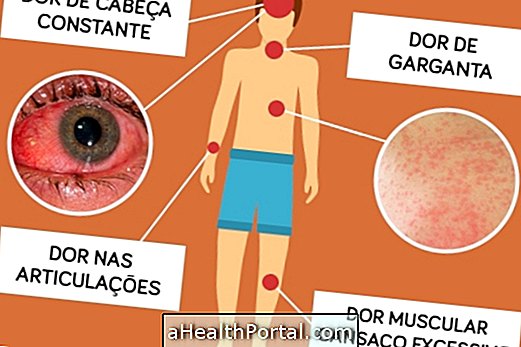Although there is no cure for multiple sclerosis, there are medications that aid in treatment, reducing inflammatory activity and outbreaks over time, thereby reducing the symptoms of physical disability characteristic of the disease.
Generally, treatment for multiple sclerosis includes:
- Remedies that reduce the risk of outbreaks by reducing the activity of immune cells;
- Remedies that treat the acute outbreak, which reduce acute inflammation, such as corticosteroids;
- Remedies used in symptomatic therapy, which serve to alleviate the manifestations of the disease and improve the quality of life.

Remedies that prevent disease progression
In determining the treatment, the physician should take into account factors such as the efficacy and safety of the medication, the person's profile and other treatments that he is doing, but especially the clinical form of the disease.
1. Interferon beta
Interferon beta is one of the most commonly prescribed immunomodulatory medications to treat multiple sclerosis, which reduces the frequency and severity of the outbreaks.
The most common side effects include injection site reaction, characteristic flu symptoms such as fever, headache, sneezing and runny nose and liver damage, so blood tests should be done to monitor liver enzymes.
Some people taking this medicine may develop antibodies that may reduce the effectiveness of other drugs.
2. Ocrelizumab
Ocrelizumab, under the trade name Ocrevus, is a humanized recombinant monoclonal antibody that works by modulating the immune system, but its mechanism of action is not yet known.
The most common side effects that can be caused by this remedy are injection site reactions, blood pressure lowering, fever and nausea. In addition, it can also increase the risk of cancer, namely breast cancer. Learn more about this medicine.
3. Glatiramer Acetate
Glatiramer Acetate is composed of a set of synthetic polypeptides capable of regulating the immune system, helping to block myelin immune system attack.
The most common side effects include injection site irritation, infection, anxiety, depression, headache, feeling sick, joint and back pain, and feeling weak.
4. Dimethyl fumarate
This is a remedy that prevents the immune system from damaging the brain and spinal cord, which helps slow the worsening of the disease
The most common side effects that may occur during treatment are diarrhea, nausea, and a decrease in the number of white blood cells in the blood.
5. Fingolimod
Fingolimod is a medicine that helps decrease the number of relapses, slowing down the symptoms of the disease. This medicine can change the way the immune system works, preventing inflammation-causing cells from reaching the brain, which reduces nerve damage caused by multiple sclerosis.
The most common side effects that can occur with the use of this medication are headache, high blood pressure, blurred vision and reduced heart rate, so it is important to monitor the heart within hours of the first dose.
6. Teriflunomide
Studies have shown that teriflunomide, commercially known as Aubagio, significantly reduces the occurrence of outbreaks, the risk of progression of disability, and the inflammatory activity of the lesions. Learn more about this medicine.
The most common side effects that can occur during treatment are liver damage and hair loss. This medicine is harmful to the developing fetus and therefore should not be used by pregnant women or those who wish to become pregnant and, in this case, should not be used by the male partner.
7. Natalizumab
Natalizumab, known commercially as Tysabri, is a humanized monoclonal antibody that blocks the movement of potentially harmful immune cells from the bloodstream to the brain and spinal cord.
The most common side effects that can be caused by this medication are headache, tiredness, infections, depression and pain in the extremities. This medicine increases the risk of a viral infection of the brain called progressive multifocal leukoencephalopathy in some people.
8. Alemtuzumab
This medication helps reduce the potential damage to the nerves caused by white blood cells, but on the other hand, it increases the risk of infections and autoimmune disorders.
The most common side effects that can occur with the use of this remedy are reactions associated with perfusion, infections, and thyroid disorders.
9. Mitoxantrone
Commercially known as Mitostate, this immunosuppressant inhibits the proliferation of T and B lymphocytes, the production of antibodies by B cells and the destruction of myelin mediated by macrophages. Find out what it is for and what the side effects of mitoxantrone are.
This medicine may be harmful to the heart and is associated with the development of blood cancer and therefore its use in the treatment of multiple sclerosis is extremely limited. Mitoxantrone is usually used only to treat the disease at a severe and advanced stage or for people who have not responded to other treatments.
In the table below are listed all types of Multiple Sclerosis and the medications usually prescribed for each of them:
| Isolated clinical syndrome | Surge-remission (SR) | Fast moving SR | Progressive secondary with outbreaks | Progressive relapsing |
| Interferon beta | Interferon beta | Natalizumab | Interferon beta | Mitoxantrone |
Glatiramer Acetate | Glatiramer Acetate | Fingolimod | Mitoxantrone | |
| Teriflunomide | Teriflunomide | Alemtuzumab (2nd line) | ||
| Dimethyl Fumarate | ||||
| Alemtuzumab | ||||
| Natalizumab (2nd line) | ||||
| Fingolimod (2nd line) | ||||
| Alemtuzumab (2nd line) |
Remedies used to treat acute episodes
When an outbreak of multiple sclerosis occurs, medications that have an action to control acute inflammation, such as steroids, should be given.
Corticosteroids, such as oral prednisone and intravenous methylprednisolone, are prescribed to reduce nerve inflammation. The most common side effects of these medications may include insomnia, increased blood pressure, mood changes, and fluid retention.

Remedies used for symptomatic treatment
For people suffering from multiple sclerosis, in addition to treatment with medications that delay the symptoms of the disease, a healthy lifestyle should be promoted through an adapted diet, regular physical activity, when tolerated, physical therapy, correction of vitamin deficiency D and Omega 3 supplementation.
Watch the following video and see how to do the recommended exercises for multiple sclerosis:

In addition, it is very important to control the symptoms that arise through symptomatic therapy. These symptoms usually include muscle contractions, tiredness, weakness, pain, sexual dysfunction, depression and uncontrolled bladder and bowel:
- Lack of motor coordination and tremors: clonazepam;
- Involuntary increase in muscle contractions: baclofen, diazepam, tizanidine, dantrolene, cyclobenzaprine hydrochloride;
- Weakness: aminopyridine, diaminopyridine, fampridine;
- Pain: anticonvulsants, such as carbamazepine, phenytoin, gabapentin, pregabalin, antidepressants such as amitriptyline, nortriptyline, desipramine, venlafaxine or antiarrhythmics such as mexiletine;
- Urinary dysfunction: propantheline bromide, oxybutynin, tolterodine tartrate or solifenacin;
- Depression: fluoxetine, sertraline, amitriptyline, nortriptyline, desipramine, venlafaxine;
- Tiredness: amantadine, methylphenidate, modafinil;
- Cognitive problems: donepezil hydrochloride;
- Sexual dysfunction: sildenafil, tadalafil, vardenafil.
Treatment for multiple sclerosis should be established by the physician and the person should be monitored frequently in order to adapt the medications as the disease progresses. It is important that the person never self-medicate, even if any of the above symptoms occur.



















